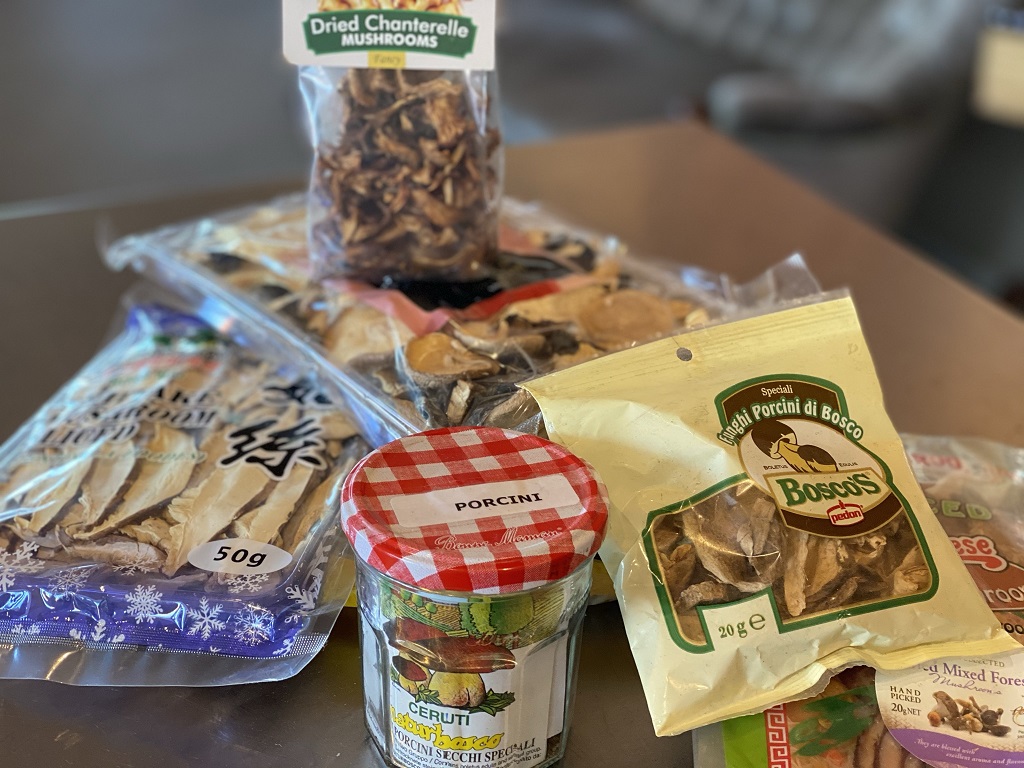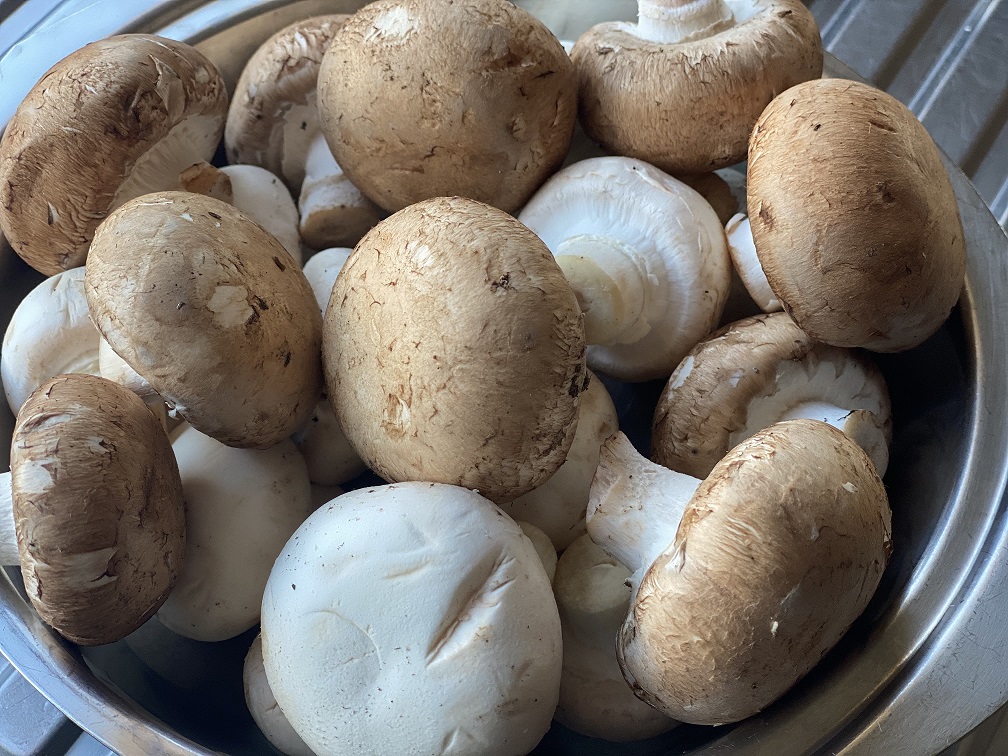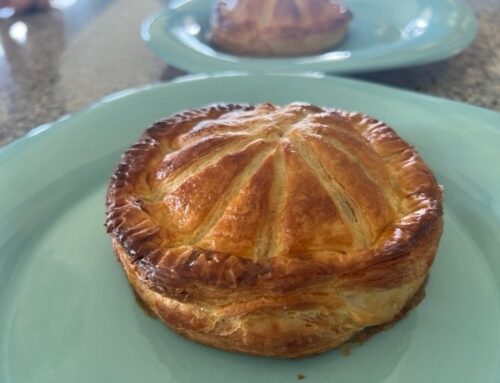Years ago, as a small child in the May school holidays, my mother and I always drove to visit my grandparents at their farm in central Victoria. May meant it was mushroom time and so we would ‘go mushrooming’, usually on Sunday afternoons. Armed with a big bucket and small knife, we would drive out into ‘mushroom’ country. My grandparents knew where the best mushrooms grew. Oblivious, to the farmers who owned the properties, we would climb the fences and go picking mushrooms. No one seemed to mind us ‘trespassing’; there must have been plenty for everyone to share. There were very few concerns about mistaking the poisonous ones. The ‘old people’ knew which were fine to eat. Our biggest worry was the bulls we would see occasionally and believe me they do charge you especially if dressed in a red jumper or coat! After the mushroom gathering, we would go back to the farmhouse for my Nana to cook up our delicious mushrooms into a simple ‘ragù, with onions, some fresh herbs, butter and cream. A little like my recipe at the end of these notes. The hardest job was to clean them of soil and grass, which we did very gently with a soft brush. These field mushrooms had the best flavour and I can still smell their aromas.
In autumn, especially in May, mushrooms are at their best. June is still good for them too, so it is not too late now. They are a nutrient-dense versatile food, they taste delicious, are readily available both fresh or dried, have good textual qualities and are so easy to use.
Dried, dehydrated, mushrooms
These are mostly imported from Europe and Asia. I always keep a variety in the pantry, ready for a quick rehydration for a sauce with steak or chicken or in broths or stocks. They can be stored for up to year, are easily reconstituted and can replace fresh mushrooms in most recipes. You can dry your own in a food dehydrator, but specialty stores and most Asian grocers usually have a good selection.
Like the fresh ones, they come in all shapes and sizes. In my pantry, I have dried shitake mushrooms (shee-tah-kee), black fungus oyster and King Oyster, porcini, and chanterelles. When reconstituted they come to about six to eight times their dry weight.
Re-hydration is easy. Soak them in warm water for 20-30 minutes or until they’re fully re-hydrated, then drain, strain the juice and dry the mushrooms; chop them, if necessary, and use them as you would fresh ones.
If you are more adventurous, use wine, Madeira or stock instead of water. Whatever the liquid, don’t throw it out, this is a fantastic broth, great in soups and sauces and if you don’t need it at the time, freeze it for later.
Another method of using these dried mushrooms is to pulverise or blitz them into a powder in a blender or spice grinder. Use this powder to flavour dishes or sauces, but be careful how much you use; being dried the flavour is a lot more intense.
Fresh mushrooms
To prepare fresh mushrooms: wipe them well with kitchen paper to remove any dirt, or use a soft brush. Never wash them as they will absorb the water; do not peel them as the skin is fine to eat and adds flavour and colour. Trim the stem to have a fresh cut. If you remove any of the stems, keep them and add them into the stock or sauce.
Cut the mushrooms according to the nature and purpose of your dish. Sometimes, if the mushrooms are tiny, you may like to cook them whole. To use in a ragù sauce, requiring some bulk, large quartered pieces may suit best. In a sauce to accompany your meat, either finely slice or dice them. Some sauces require a very fine duxelles dice to add to the fine, more formal, appearance of the dish.
How to cook mushrooms for the best flavour: always cook them in hot, sizzling butter with some extra virgin olive oil to stop the butter from burning; cook them in small batches to caramelise them well. Too many in a pan all at once, reduces the heat in the pan, the mushrooms release their juices and they stew and never caramelise or brown. If you melt too much butter and oil, pour some off and set aside to be added, if necessary, during the cook. They will stew if there is too much butter and oil in the pan.
Simply tossed in the pan and served: cook the cleaned mushrooms, whole or sliced, in the frying pan with hot, sizzling butter and extra virgin olive oil until they are golden brown, add some finely diced garlic and caramelise them. And eat them just like this.
Or, you can add a splash of white or red wine, some stock, reduce by half, add a handful of chopped parsley or other fresh herbs and let them soak up all of that flavour properly. Some cream will give you an even richer finish. Some dried porcinis are the good to add with your fresh mushrooms for this, especially when accompanying steak.
And as a luscious sauce: mushrooms cooked into a rich, creamy and delicious mushroom sauce are heavenly. Use any mushroom you can think of and be adventurous. Portobellos, field, King oyster, pine, Swiss browns and some dried porcini or mixed forest mushrooms.
| Ingredients | |
| 1 tbsp dried porcini or mixed forest mushrooms 350g mixed mushrooms, the wilder variety, the better 3 tbsp butter 20ml olive oil 1 tbsp finely chopped garlic 1 tbsp thyme leaves |
30 ml brandy 250 ml white wine 1 litre chicken stock 250 ml cream Sea salt and freshly cracked pepper Garnish ½ cup flat-leaf parsley, finely chopped |
Rehydrate the dried porcini in warm water to cover them, for 10 minutes or so until soft, drain, strain and save the mushroom water.
Wipe the mushrooms clean with kitchen paper. Cut the mushrooms into small chunks the size of halved button mushrooms.
Melt the butter with the olive oil in a large pan over a medium heat and wait for it to turn nutty and golden.
Immediately add the mushrooms, in small batches, spreading them out evenly in the pan, but not stirring them.
After 3 to 5 minutes, turn the mushrooms to brown the other sides, and continue this until they are caramelised all over. If you stir them too early, they will release the juices and you will lose caramelisation.
Once they are all golden, add the garlic and thyme and stir well until fragrant.
Pour in the brandy and flambé, that is light the brandy to burn off the alcohol. Otherwise, just wait for it to cook off.
Add the wine and cook it down until the mixture is dry.
Next, add the chicken stock and let it reduce by half.
Add the cream, reduce the heat to low and allow it to thicken, stirring occasionally.
Once thickened, season with sea salt and freshly cracked pepper.
Finish with a garnish of freshly chopped parsley.
- Swiss and button mushrooms
- Sliced enjoying some sunshine
- White flat mushrooms










